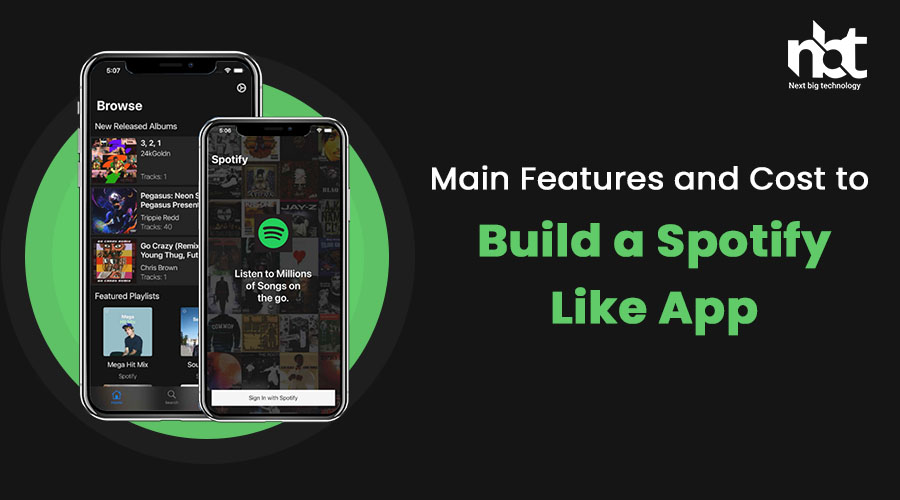Introduction:
Spotify has transformed the way we listen to music, offering a vast library of songs, personalized playlists, and seamless streaming experiences. If you’re inspired by the success of Spotify and considering building a similar app, it’s important to understand the main features required and the associated costs to create a robust music streaming platform. In this comprehensive guide, we will explore the main features and cost factors to consider when building a Spotify-like app. Let’s dive in!
I. Main Features of a Spotify-Like App:
- User Registration and Profiles:
- Allow users to create accounts, set up profiles, and manage personal information, including their music preferences, favorite artists, and playlists.
- Music Library and Catalog:
- Provide a vast collection of songs, albums, and artists from various genres, ensuring a comprehensive music library for users to explore.
- Personalized Recommendations:
- Utilize algorithms and user behavior analysis to offer personalized music recommendations based on listening history, liked songs, and favorite genres.
- Playlist Creation and Management:
- Enable users to create and manage their own playlists, adding songs from the music library or their liked tracks.
- Offline Listening:
- Allow users to download songs or playlists for offline listening, providing uninterrupted music playback even without an internet connection.
- Search and Discovery:
- Implement a powerful search functionality that allows users to find songs, albums, artists, or playlists by keywords, genres, moods, or specific criteria.
- Social Sharing and Collaborative Playlists:
- Enable users to share their favorite songs or playlists with friends and allow collaborative playlist creation, where multiple users can contribute to the same playlist.
- Radio and Discover Mode:
- Provide curated radio stations or “discover” modes that introduce users to new artists and songs based on their music preferences.
- Lyrics and Song Information:
- Display lyrics and additional song information, such as album details, release date, and artist bios, enhancing the overall music listening experience.
- Music Quality and Streaming:
- Offer high-quality audio streaming options, including standard and high-definition formats, to ensure optimal sound quality for users.
- Cross-Platform Compatibility:
- Ensure seamless music playback and synchronization across different devices, allowing users to access their music library from multiple platforms.
- Personalized Music Charts:
- Display personalized music charts or trending playlists based on user preferences and popular songs within the app’s community.
- Podcasts and Audio Content:
- Expand the app’s offerings by integrating podcasts, audiobooks, or other audio content, providing a diverse range of entertainment options.
- Integration with Third-Party Services:
- Integrate with external services, such as music ticketing platforms or merchandise stores, to enhance the overall user experience and revenue opportunities.
II. Cost Factors to Consider:
- Platform Selection:
- Determine whether you want to build the app for iOS, Android, or both platforms. The choice will impact development costs and timeframes.
- App Design and User Interface:
- Investing in intuitive and user-friendly app design is crucial to providing a seamless music streaming experience. Costs may vary based on design complexity and customization requirements.
- Development Team:
- Hiring experienced developers, designers, and quality assurance specialists is essential for building a robust and feature-rich music streaming app. The team size will impact costs.
- App Development Approach:
- Decide between native or cross-platform development. Native apps offer better performance but require separate development for iOS and Android. Cross-platform solutions can reduce development time and costs.
- Backend Infrastructure:
- Building a scalable backend infrastructure to handle music storage, streaming, user management, and personalized recommendations is critical. Costs will vary based on infrastructure complexity and hosting requirements.
- Licensing and Royalties:
- Consider the costs associated with obtaining necessary licenses and paying royalties to artists and record labels for music streaming rights.
- Music Data and Metadata Integration:
- Allocate resources for integrating music databases or APIs to retrieve and update song metadata, including titles, artists, albums, and other relevant information.
- Third-Party Integrations:
- Consider the need for integrating third-party services, such as lyrics databases or music analytics tools, which may incur additional costs.
- Testing and Quality Assurance:
- Allocate resources and budget for thorough testing to ensure the app’s functionality, performance, and music streaming quality.
Conclusion:
Building a Spotify-like app requires careful consideration of the main features and cost factors involved in creating a robust music streaming platform. Costs will vary depending on factors such as platform selection, app design, development approach, team size, and desired features and functionality. Prioritize the main features based on your target audience and business goals to control costs while ensuring the app’s reliability and user satisfaction. By considering the main features and cost factors discussed in this guide, you can lay a solid foundation for developing a successful Spotify-like app that offers a seamless and immersive music streaming experience to users worldwide.

















